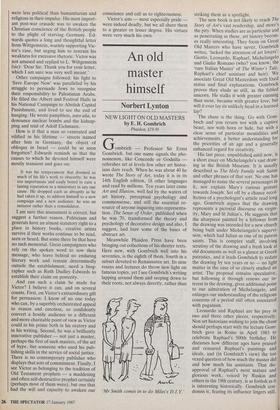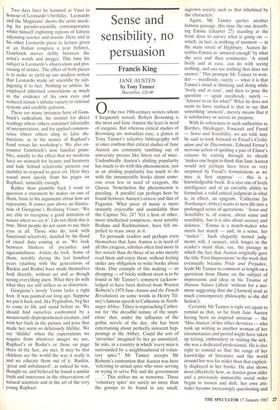An old master himself
Norbert Lynton
NEW LIGHT ON OLD MASTERS by E. H. Gombrich Phaidon, L19.95 Gombrich — Professor Sir Ernst Gombrich, but one name signals the phe- nomenon, like Concorde or Godzilla refreshes art at levels few other art histor- ians dare reach. When he was about 40 he wrote The Story of Art, today it is in its 14th English edition, 18 other languages and read by millions. Ten years later came Art and Illusion, well fed by the waters of art history, perceptual psychology and commonsense, and still the essential re- source of anyone inquiring into representa- tion. The Sense of Order, published when he was 70, transformed the theory and psychology of decorative design and also, I suggest, laid bare some of the bases of abstract art.
Meanwhile Phaidon Press have been bringing out collections of his shorter texts. Here now, with Gombrich well into his seventies, is the eighth of them, fourth in a subset devoted to Renaissance art. Its nine essays and lectures do throw new light on famous topics, yet I see Gombrich's writing lapping around them and seeping down to their roots, not always directly, rather than `Mr Smith comes in to do Miles's D.1.Y.' striking them as a spotlight. The new book is not likely to reach The Story of Art's vast readership, and more's the pity. When studies are as particular and as penetrating as these, art history becom- es really interesting. They focus on Great Old Masters who have never, Gombrich writes, 'lacked the attention of art lovers': Giotto, Leonardo, Raphael, Michelangelo and Giulio Romano (who? you know, the `rare Italian Master' of The Winter's Tale, Raphael's chief assistant and heir). We associate Great Old Masterdom with fixed status and final explanations. Gombrich proves they elude us still, as the fabled unicorn. He stalks it with greater cunning than most, because with greater love; but will it ever lay its unlikely head in a learned lap?
The chase is the thing. Go with Gom- brich and you return not with a captive beast, nor with horn or hide, but with a clear sense of particular mentalities and achievements, a better understanding for the priorities of an age and a generally enhanced regard for creativity. His last piece, unpublished, until now, is a short essay on Michelangelo's vast draw- ing in the British Museum. It is usually described as The Holy Family with Saints and other phrases of that sort. No one has managed to name the several personages in it, nor explain Mary's curious gesture towards Joseph. Set off by a chance recol- Iction of a psychologist's article read long ago, Gombrich argues that the drawing represents a pictorial discourse on virgin- ity, Mary and St Julian's. He suggests that the altarpiece painted by a follower from the drawing was intended for a new church being built under Michelangelo's supervi- sion, which had Julian as one of its patron saints. This is complex stuff, involving scrutiny of the drawing and a fresh look at old documents as well as a glance at Greek patristics, and it leads Gombrich to redate the drawing by ten years or so — no light matter in the case of so closely studied an artist. The proposal remains speculative, but following it through renews our in- terest in the drawing, gives additional point to our admiration of Michelangelo, and enlarges our understanding of the religious concerns of a period still often associated with paganism.
Leonardo and Raphael are his prey in two and three other pieces, respectively. Non art historians wishing to join the chase should perhaps start with the lecture Gom- brich gave in Rome in April 1983 to celebrate Raphael's 500th birthday. He discusses how different ages have praised and censured Raphael's paintings and ideals, and (in Gombrich's view) the too vexed question of how much the master did and how much his assistants. That dis- approval of Raphael's most mature and glorious work, voiced by Ruskin and others in the 19th century, is as foolish as it is interesting historically. Gombrich con- demns it, fearing its influence lingers still. Two days later he lectured at Vinci in honour of Leonardo's birthday. 'Leonardo and the Magicians' shows the artist mock- ing his pseudo-scientific contemporaries whilst himself exploring regions of fantasy adjoining science and reason. Here and in his other Leonardo piece (a lecture given at an Italian congress a year before), Gombrich moves deftly between the artist's words and images. This time his subject is Leonardo's observation and pro- cessing of nature. The effect of both pieces is to make us yield up our modern notion that Leonardo made art scientific by sub- jugating it to fact. Nothing so artless: he employed inherited conventions as much as the evidence of his own eyes and reduced nature's infinite variety to rational systems and credible patterns. There are many instances here of Gom- brich's radicalism, his instinct for direct readings where others construct labyrinths of interpretation, and for applied common- sense where others cling to false dis- tinctions, as in the matter of Raphael's hand versus his workshop's. We also en- counter Gombrich's now familiar grum- bles, usually to the effect that we moderns have no stomach for beauty and harmony and hide behind relativistic pretexts our inability to respond to great art. Here they sound most openly from his pages on Raphael, naturally enough.
Rather than grumble back I want to question a statement he makes on one of them, basic to his arguments about how art represents. It comes just above an illustra- tion of Giorgione's Reclining Venus: 'We are able to recognise a good imitation of nature when we see it'. I do not think this is true. Most people do not seem to use their eyes at all. Those who do, look with functional selectivity, dazzled by the flood of visual data coming at us. We look between blinkers of prejudice and squeamishness. Artists do look. Some of them, notably during the last hundred years (starting with the generations of Ruskin and Rodin) have made themselves look directly, without art and as though seeing everything anew. What they do with what they see still strikes us as distortion.
Giorgione's lovely Venus lacks a right foot. It was painted out long ago. Suppose we put it back and, like Pygmalion, beg her to come to life and stand before us. We should find ourselves confronted by a monstrously disproportioned creature, and wish her back in the picture and pose that made her seem so deliciously lifelike. We say 'lifelike' when the expectations we acquire from whatever images we use, Raphael's or Rodin's or those on page three of the Sun, are met. It may he that children see the world the way it really is and we educate them out of it. Ruskin, 'great and unbalanced', as indeed he was, thought so, and believed he found a similar truth and innocence in the observations of natural scientists and in the art of the very young Raphael.











































 Previous page
Previous page